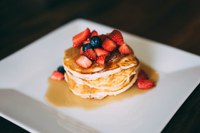Prairie Fare: Are You Exploring Your Freezer for Menu Options?
(Click an image below to view a high-resolution image that can be downloaded)
By Julie Garden-Robinson, Food and Nutrition Specialist
NDSU Extension
I took a bite of homemade buttermilk pancakes.
Having breakfast for dinner is one of my favorite meals.
Then I took a bite of sausage. The more I chewed, the worse it tasted. I also noticed it had a bad aroma.
“How old is this sausage?” I asked my husband, who was head chef that evening.
I heard a heavy sigh coming from the kitchen.
“It’s pretty old,” he responded. “I found it in the freezer and I didn’t think you’d notice.”
Fortunately, I still have a pretty good sense of taste and smell. Did you know that loss of smell and taste can be a symptom of COVID-19?
Our older daughter sat down at the table.
“Don’t eat the sausage,” I advised as I looked at her plate.
“Dad, I think this is going to be a column,” our daughter remarked with a grin.
Then she began “writing” my column as we sat at the dinner table. Her version was funnier than my version, I think.
“The pancakes are excellent,” I said as my husband joined us at the dinner table.
Like many other people, lately we have been “mining” our freezer to develop dinner menus and use up food during the pandemic.
Most of the time, frozen food is safe, although it might be a little freezer-burned from dehydration. Sometimes, however, frozen food becomes inedible.
Upon further investigation, I found the packaging in the trash. One of us must have put the plastic-wrapped package of sausage in the freezer without popping it into a freezer bag or rewrapping it in butcher paper.
Sometimes, we get in a rush to store food upon returning from the grocery store. I might have been the culprit.
We definitely do not like to waste food in our home. No one does. This sneaky package of sausage links was a stowaway under some other food packages.
Usually, a plastic-wrapped meat package directly from the store is fine for a month or two in the freezer. A year had passed and rancidity development had occurred.
When oxygen interacts with fat in almost any type of food without preservatives, objectionable odors and flavors can result. “Oxidation” occurs when oxygen triggers chemical changes in the fat. This natural process can result in undesirable flavors and odors in high-fat foods such as nuts, high-fat meats or snack foods.
If you look at ingredient labels on some products, you might see natural or artificial preservatives added to the food to prevent these chemical changes.
As you consider packaging materials for foods to prolong frozen storage time, look for materials that are moisture resistant. It should be made of “food grade” material; in other words, the materials should be designed for use in direct contact with food products.
The material should be durable and leak-proof. It should not become brittle and crack at freezer temperatures of zero F. It should protect foods from off flavors and odors, and be easy to fill, seal and store. It also should be easy to mark with the contents/date.
If you buy meat for long-term quality in frozen storage, use good-quality freezer paper and/or freezer bags. Freezer paper has a plastic or wax lining that helps reduce exposure of the meat to oxygen. Aluminum foil also works well as an outer wrapper because it conforms well to the food.
If you use plastic freezer bags, be sure they say “freezer bags” instead of “storage bags” because the thickness of the plastic differs. Be sure to press the air out of the packaging.
Some people invest in a vacuum sealer to package food while removing oxygen. Be sure to follow the manufacturer’s directions.
To view a comprehensive guide about freezing foods from NDSU Extension, see https://tinyurl.com/NDSUExtensionFoodFreezingGuide for details.
Try some pancakes for dinner. They’re delicious with fresh fruits such as strawberries, which are in season in the spring. Fresh breakfast sausage also is a nice accompaniment.
Buttermilk Pancakes
2 c. buttermilk (or substitute reconstituted dry buttermilk)
2 eggs, beaten
1/2 tsp. salt
1 tsp. baking soda
2 tsp. baking powder
2 Tbsp. sugar
1 3/4 c. all-purpose flour
2 Tbsp. butter or margarine, melted
Preheat griddle to 375 degrees. Mix buttermilk and eggs together. In separate bowl, stir dry ingredients together (or use a sifter). Stir in buttermilk and egg mixture. Add melted butter and mix. Drop from ladle onto hot griddle, cooking each side about two minutes or until light brown. Flip when you see bubbles.
Makes six servings. Each serving has 240 calories, 6 grams (g) fat, 9 g protein, 36 g carbohydrate and 720 milligrams sodium.
(Julie Garden-Robinson, Ph.D., R.D., L.R.D., is a North Dakota State University Extension food and nutrition specialist and professor in the Department of Health, Nutrition and Exercise Sciences. Follow her on Twitter @jgardenrobinson)
NDSU Agriculture Communication - May 14, 2020
| Source: | Julie Garden-Robinson, 701-231-7187, julie.garden-robinson@ndsu.edu |
|---|---|
| Editor: | Ellen Crawford, 701-231-5391, ellen.crawford@ndsu.edu |




